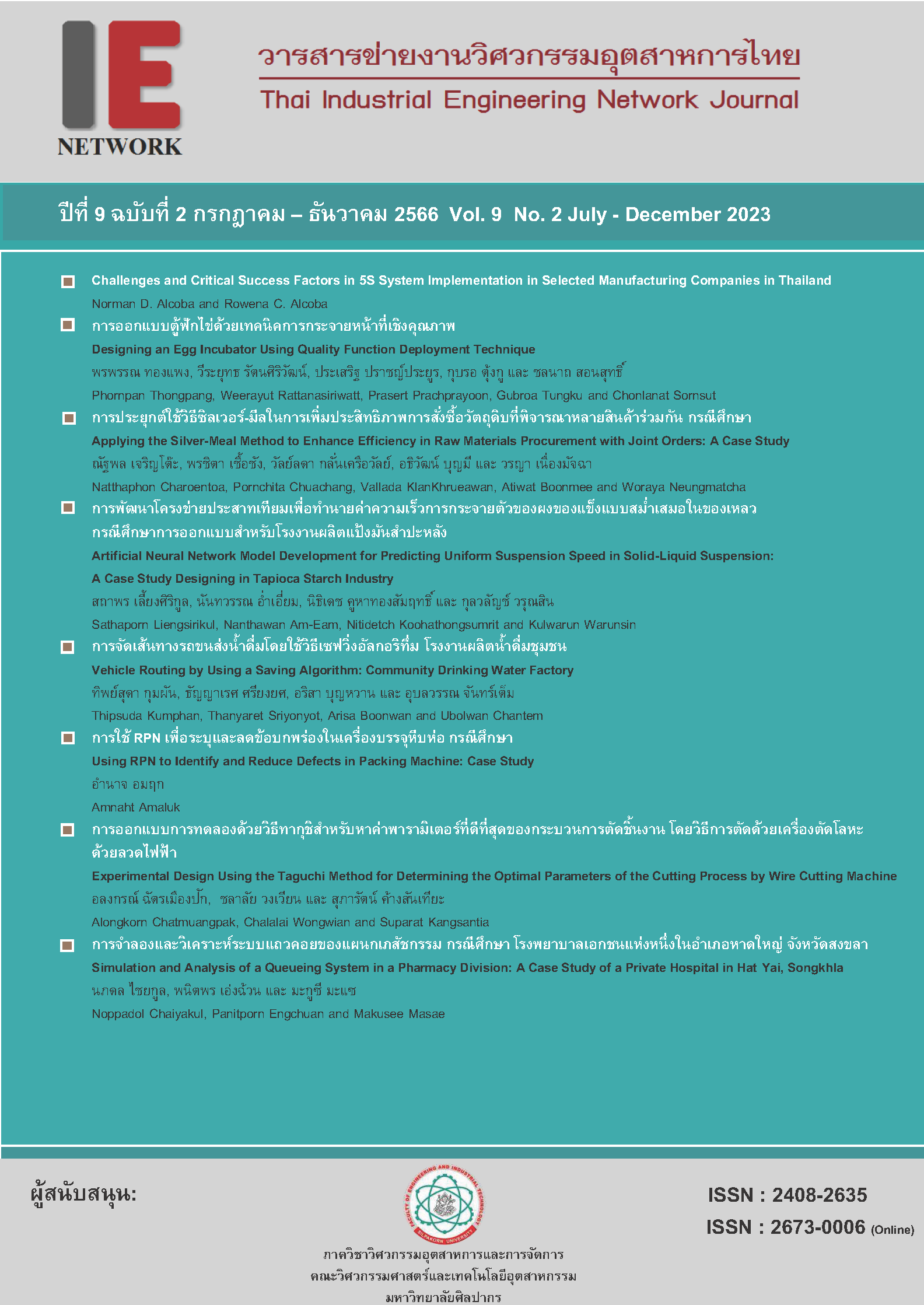Experimental Design Using the Taguchi Method for Determining the Optimal Parameters of the Cutting Process by Wire Cutting Machine
Main Article Content
Abstract
The objective of this research is to study the surface roughness values obtained by adjusting the parameters of a wire-edged metal cutting machine by using the Taguchi experimental design method to analyze the parameters in cutting influences roughness and the material used in the experiment was SKD 11 mold steel. The workpiece was cut using the Wire Cutting Machine method. using electronic wire Brass rod size 0.25 mm. The workpiece was cut to a thickness of 10 mm. Experiments were conducted using the Taguchi method of cross-variables according to the experimental table . For the control factors studied there were 3. Factors include voltage, 2. IP-on-time electric current (On Time), 3. Wire speed. The results of the experiment found that the discharge current There is a significant influence on the surface roughness value for the discharge voltage and feed rate. It did not affect the surface roughness in this experiment and the experimental conditions that gave the lowest surface roughness values from this study were the voltage at 50 volts, the IP current value. On Time (On Time) at 12 amperes, wire speed at 6 mm./minute, which obtained the best surface roughness value at 3.346 micrometers (μm) from the experiment in increasing the electric current. A higher charge rate will result in an increase in the formation of a small surface roughness layer.
Article Details

This work is licensed under a Creative Commons Attribution-NonCommercial-NoDerivatives 4.0 International License.
บทความ ข้อมูล เนื้อหา รูปภาพ ฯลฯ ที่ได้รับการตีพิมพ์ในวารสารฯ ถือเป็นลิขสิทธิ์ของวารสารฯ หากบุคคลหรือหน่วยงานใดต้องการนำทั้งหมดหรือส่วนหนึ่งส่วนใดไปเผยแพร่ต่อหรือเพื่อกระทำการใดๆ จะได้รับอนุญาต แต่ห้ามนำไปใช้เพื่่อประโยชน์ทางธุรกิจ และห้ามดัดแปลง
References
B. Thomas, Technology of Electrical Discharge Machining, Druckerei Helene, 6102 Pfunstste, 1997, pp. 11-53
Lee, S.H. and Li, X.P. Study of the Surface Integrity of the Machined Workpiece in the EDM of Tungsten Carbide. Journal of Materials Processing Technology, 2003; Vol.139.
กมลพงค์ แจ่มกลม และ ปิยะพงค์ ค้ำคุณ. การออกแบบและสร้างอุปกรณ์ช่วยในการจับยึดชิ้นงานสำหรับกระบวนการตัดแบบหลายขั้นตอนบนเครื่องตัดโลหะด้วยลวดไฟฟ้า. วารสารวิจัย มทร.กรุงเทพ. 2564; ปีที่ 15(2).
ธนกานต์ วิชิระประเสริฐ และ ทศพล เกียรติเจริญผล. การออกแบบการทดลองด้วยหลักการค้นหาตัวแปรของไชนิน และวิธีการทากุชิกรณีศุกษากระบวนการย้ำหมุดอลูมิเนียม. วารสารวิศวกรรมสาร มหาวิทยาลัยนเรศวร. 2559; ปีที่ 11(1): หน้า 7-13
Geometrical Product Specifications. 2018. Indication of surface texture in technical product documentation. JIS B 0031; 2003(Ed): pp. 511
พิชัย จันทร์มณี, กมลพงค์ แจ่มกมล, อภิวัฒน์ มุตตามระ. การศึกษาผลกระทบของ พารามิเตอร์ในการตัดวัสดุทังสเตนคาร์ไบด์โดยการกัดกร่อนด้วยลวดไฟฟ้า ด้วยวิธีทากูชิ. วารสารวิศวกรรมสาร มหาวิทยาลัยนเรศวร. 2554; ปีที่ 6(1): หน้า 20-27
Krishankant, Jatin Taneja, Mohit Bector, Rajesh Kumar. 2012. Application of taguchi method for optimizing turning process by the effects of machining parameters, International Journal of Engineering and Advanced Technology (IJEAT). 2012; Vol. 2 (1).

